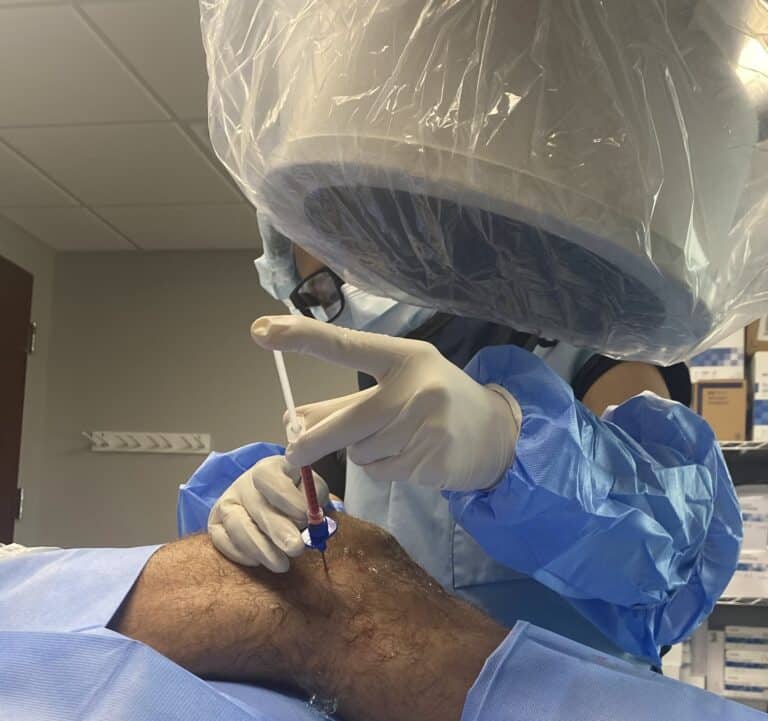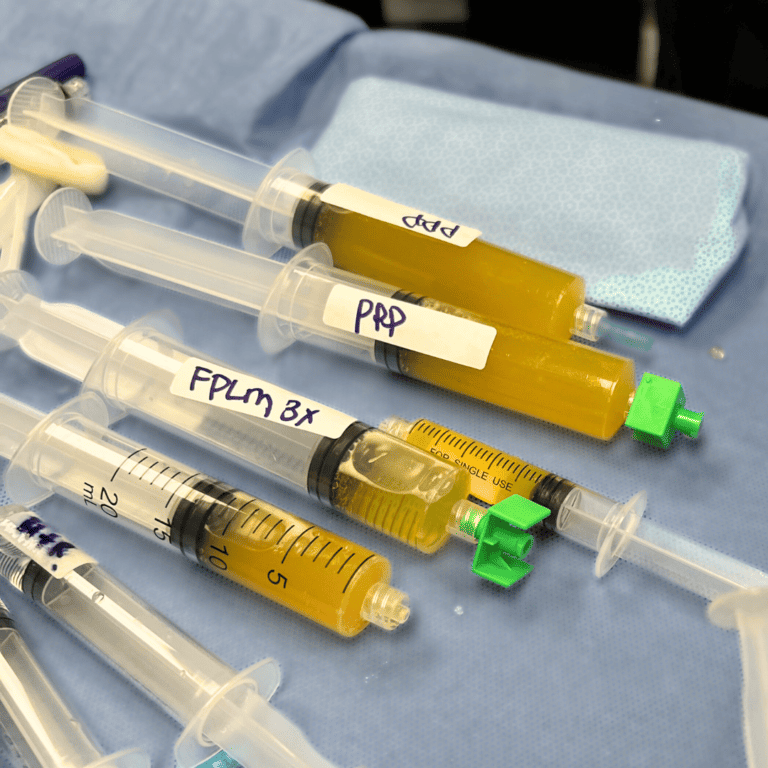Total knee replacements are occurring very often and many may be entirely unnecessary! Effective nonsurgical options are now available. In some cases, the knee pain may actually be stemming from the hip or spine; this is called referred pain. Almost one-third of knee replacements are deemed inappropriate when strictly evaluated. There are many regenerative-medicine options, such as autologous (coming from one’s own body) injections, that could potentially relieve pain and increase activity levels without cutting away pieces of meniscus or frayed cartilage, and replacing the knee with a foreign device. If your knee pain is due to a spinal condition, there are also nonsurgical options for spinal treatment.
Here are six reasons to consider other options than a knee joint replacement:
1) Chronic Knee Pain
Studies have shown that many patients have continued pain after their knee replacement. Sometimes it is greater than or equal to their pre-surgical pain.
One of the reasons that the pain does not subside after surgery is referred pain. If pain in the knee was caused by spinal nerves, the pain will not be eliminated after a knee replacement! You should not have surgery on your knee if what you truly are experiencing is a condition in your back.
There are signs to look for to determine if your back may be the cause of your knee pain; hamstring tightness, bunion formation, or if you are experiencing both back and knee pain. There is no guarantee that you will experience any of these symptoms if your knee pain stems from the low back. A low back condition can present itself solely as knee pain! However, if your knee pain is accompanied by back pain, it would absolutely be a sign to avoid knee replacement surgery until it is evaluated properly.
2) Expectation May Not Meet Reality
There are advertised depictions of middle-aged and elderly people who are running or playing sports with their families allegedly after knee replacement surgery. Unfortunately, only 5% or less (1 in 20 people) actually achieve this level of physical activity following a knee replacement.
Patients who are 55 years old or younger have been increasingly offered knee replacements. Younger patients tend to be much more active and 15% of younger patients actually undergo another surgery to revise their knee replacement just five years after their original surgery.
3) Tissue Damage Caused by Metal Ions in the Blood
Wear particles are microscopic pieces of metal, ceramic, or plastic that break off of the joint replacement, irritate the local tissues, and/or enter the bloodstream. These particles have been the subject of many studies and lawsuits. Minimally invasive knee replacements involve only partial replacements or resurfacing. These smaller devices must all be metal to withstand the stresses of the knee joint. This means more metal wear particles and ions in your bloodstream.
Many studies have demonstrated cause for concern regarding metal ions in the blood after knee replacement surgery:
These wear particles and metal ions can cause harmful metal toxicity and possibly create pseudotumors (a non-cancerous soft tissue growth that occurs when metal particles from an implant irritate local tissues). According to the FDA, other adverse reactions may include: skin rashes, cardiomyopathy, neurological changes including sensory changes (auditory, or visual impairments), psychological status change (including depression or cognitive impairment), kidney function impairment, and thyroid dysfunction.
Even when cross-linked Polyethylene is used instead of metal, a study showed that it caused knee cartilage inflammation and other break down chemicals.
4) Device Failure Caused by Allergies
There are two groups of people who are at a significantly higher risk of potential rejection, implant loosening, and/or toxicity from wear particles.
- Those with any type of allergy. Even patients with allergies as simple as pollen or dander should consider avoiding knee replacement surgery. People who are considered “allergic” have hyperactive immune systems and secrete antibodies inappropriately to rid their bodies of the thing that they have mistaken as harmful. If that is a knee replacement device, this obviously affects the outcome of a surgery.
- Those with metal sensitivities. Patients who have more specific metal allergies can have issues with the metals that are used in joint replacement prostheses.
Unfortunately, those who consider themselves to be an “allergic person” may experience more pain after a knee replacement. The cement used to bond the device to the bone can also cause an allergic reaction. In these cases, the device is more likely to fail, need to be replaced sooner, or cause chronic pain.
5) Increased Risk of Heart Attack, Stroke, and Bleeding Stomach Ulcers
Knee replacement patients aged 60+ are 31 times more likely to experience a heart attack in the two weeks following surgery. Joint replacement is a severe trauma to the blood vessels and bone marrow space. This leads to a higher risk of blood clots that could potentially cause an embolism in the heart, lungs, or brain. According to one study, blood clots in the legs that produced symptoms were found in 34% of patients.
The risk of heart attack in men who have had a knee replacement increases by 79% in the years that follow the procedure. The stress of undergoing the joint removal may be enough to trigger a stroke or a heart attack. Bleeding stomach ulcers can also occur following knee replacement. Study results show a three-fold increase in stomach bleeding for up to six weeks post-surgery.
6) Increased Risk of Hip Fracture
A Swedish study observed the medical records of the “entire Swedish population born between 1902 and 1952.” The risk for hip fracture for those who received knee replacements before surgery was relatively low. In the 10 years after, there was a 4% increase in the risk of hip fracture. In addition, there is also bone density loss in hips. There may be a correlation between the two.
Alternatives to Knee Replacement Surgery
Although many patients have tried steroid injections or gel shots to increase the lubrication of their knee joints, this is not the best approach. Steroid shots actually kill cartilage cells, stem cells, and increase cartilage breakdown. Even the commonly used local anesthetics used in the knees can be toxic to stem and cartilage cells.
Those who suffer from mild arthritis may benefit from precise injections procedures using concentrated platelet-rich plasma (PRP). These natural growth factors from your own blood-derived platelets can support healthy cartilage. The Regenexx protocols allow our physicians to provide better and more individualized platelet injections that the typical PRP kit. If you suffer from moderate or severe arthritis, precision-guided injections of your own concentrated bone marrow aspirate may be a better choice to provide relief. Your bone marrow contains many cell types, including mesenchymal stem cells.
Since there are alternative options and a great number of risks associated with knee replacement surgery, you may want to just say no while you explore your options. Our Regenexx Procedure Candidate Form is a great place to start understanding if regenerative orthopedic medicine is right for you.









